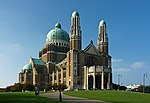Sint-Agatha-Berchem

Berchem-Sainte-Agathe (French, pronounced [bɛʁkɛm sɛ̃t aɡat]) or Sint-Agatha-Berchem (Dutch, pronounced [sɪnt aːˈɣaːtaː ˈbɛrxɛm] (listen)) is one of the 19 municipalities of the Brussels-Capital Region, Belgium. Located in the north-western part of the region, it is bordered by Ganshoren, Koekelberg and Molenbeek-Saint-Jean, as well as the Flemish municipalities of Asse and Dilbeek. In common with all of Brussels' municipalities, it is legally bilingual (French–Dutch). On 1 January 2006, the municipality had a total population of 20,078. The total area is 2.95 km2 (1.14 sq mi) which gives a population density of 6,807/km2 (17,630/sq mi). The municipality is known for its calm and peaceful character. It is said that Berchem is a "village in the city".
Excerpt from the Wikipedia article Sint-Agatha-Berchem (License: CC BY-SA 3.0, Authors, Images).Sint-Agatha-Berchem
Rue des Combattants - Strijdersstraat,
Geographical coordinates (GPS) Address Nearby Places Show on map
Geographical coordinates (GPS)
| Latitude | Longitude |
|---|---|
| N 50.866666666667 ° | E 4.3 ° |
Address
LINK42 BVBA
Rue des Combattants - Strijdersstraat 75
1082
Belgium
Open on Google Maps











